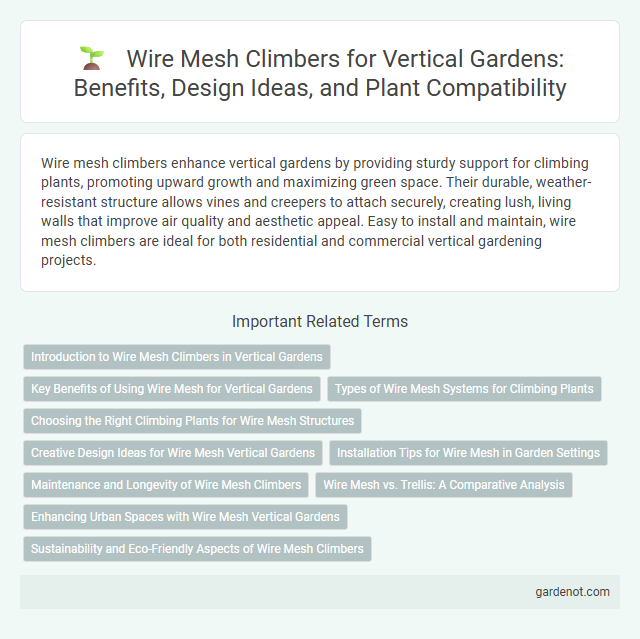Wire mesh climbers enhance vertical gardens by providing sturdy support for climbing plants, promoting upward growth and maximizing green space. Their durable, weather-resistant structure allows vines and creepers to attach securely, creating lush, living walls that improve air quality and aesthetic appeal. Easy to install and maintain, wire mesh climbers are ideal for both residential and commercial vertical gardening projects.
Introduction to Wire Mesh Climbers in Vertical Gardens
Wire mesh climbers are essential structural components for vertical gardens, providing sturdy support for plants to grow upward. These grids, typically made from galvanized steel or coated wire, ensure durability and resistance to weather conditions while allowing vines and climbers to attach naturally. By optimizing space and enhancing plant growth, wire mesh climbers contribute significantly to the aesthetic and ecological benefits of vertical gardens.
Key Benefits of Using Wire Mesh for Vertical Gardens
Wire mesh climbers provide robust structural support that promotes healthy plant growth and maximizes vertical space in gardens. Their durable, weather-resistant material ensures long-lasting performance, making wire mesh ideal for various plant types, including vines and climbers. Enhanced airflow and sunlight penetration through the mesh improve plant health while simplifying maintenance and harvesting in vertical garden setups.
Types of Wire Mesh Systems for Climbing Plants
Wire mesh climbers offer versatile support systems for vertical gardens, featuring varieties such as welded wire mesh, expanded metal mesh, and hexagonal wire mesh, each designed to accommodate different plant growth habits and load capacities. Welded wire mesh provides rigid, durable support ideal for heavy climbers like wisteria, while expanded metal mesh offers a flexible, textured surface suited for lighter vines like ivy. Hexagonal wire mesh, commonly known as chicken wire, delivers a lightweight and cost-effective solution perfect for fast-growing, delicate climbers such as sweet peas.
Choosing the Right Climbing Plants for Wire Mesh Structures
Selecting climbing plants that thrive on wire mesh structures enhances vertical garden aesthetics and plant health. Ideal choices include fast-growing vines like English ivy, clematis, and climbing roses, which securely anchor to the mesh while providing dense foliage coverage. Consider the plant's growth rate, sun exposure, and maintenance needs to ensure optimal performance on wire mesh climbers.
Creative Design Ideas for Wire Mesh Vertical Gardens
Wire mesh climbers offer versatile support structures ideal for vertical gardens, enabling plant vines to grow upward while creating intricate living walls. Incorporating geometric patterns and customizable shapes in wire mesh designs enhances aesthetic appeal and maximizes greenery coverage in limited spaces. Creative use of wire mesh allows integration of mixed plant species, fostering biodiversity and dynamic texture in vertical garden installations.
Installation Tips for Wire Mesh in Garden Settings
Secure the wire mesh climber by anchoring it firmly to a sturdy frame or wall using rust-resistant fasteners to withstand outdoor conditions. Space the mesh panels evenly, allowing sufficient gaps for plant growth and root expansion, typically 6 to 12 inches apart depending on the plant species. Maintain tension in the wire mesh during installation to prevent sagging and ensure optimal support for climbing plants' vertical growth.
Maintenance and Longevity of Wire Mesh Climbers
Wire mesh climbers require regular inspection to ensure the mesh remains securely anchored and free from rust or corrosion, which can compromise structural integrity over time. Applying protective coatings such as galvanization or powder coating extends the lifespan of wire mesh by preventing weather-related damage and reducing maintenance needs. Proper cleaning and prompt repair of any damaged sections promote healthy plant growth and preserve the vertical garden's aesthetic appeal.
Wire Mesh vs. Trellis: A Comparative Analysis
Wire mesh climbers provide a durable and flexible support system for vertical gardens, offering greater stability and ease of installation compared to traditional wooden trellises. Unlike trellises, wire mesh allows plants to attach more securely and encourages denser foliage growth by supporting multiple climbing directions. This enhanced plant support results in improved vertical coverage and longevity in outdoor or indoor vertical gardening applications.
Enhancing Urban Spaces with Wire Mesh Vertical Gardens
Wire mesh climbers transform urban spaces by providing sustainable vertical gardens that maximize limited areas for greenery. These structures support a diverse range of climbing plants, improving air quality and promoting biodiversity in cities. Integrating wire mesh vertical gardens enhances aesthetic appeal while mitigating urban heat island effects and reducing noise pollution.
Sustainability and Eco-Friendly Aspects of Wire Mesh Climbers
Wire mesh climbers promote sustainability by utilizing durable, recyclable materials that reduce environmental impact and support long-term plant growth. Their eco-friendly design minimizes plastic use and encourages natural vertical greenery, improving air quality and biodiversity in urban spaces. Installation of wire mesh climbers also reduces the need for chemical fertilizers and excessive watering, fostering an environmentally responsible gardening solution.
Wire mesh climber Infographic

 gardenot.com
gardenot.com